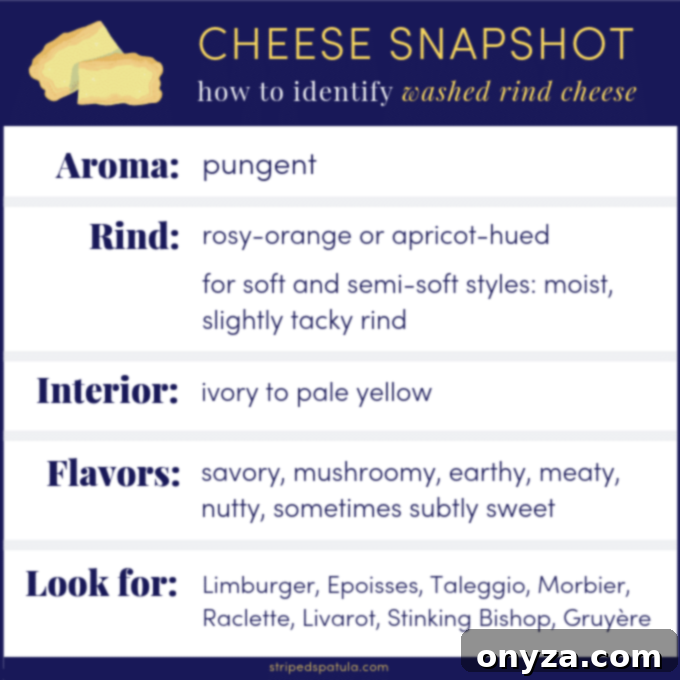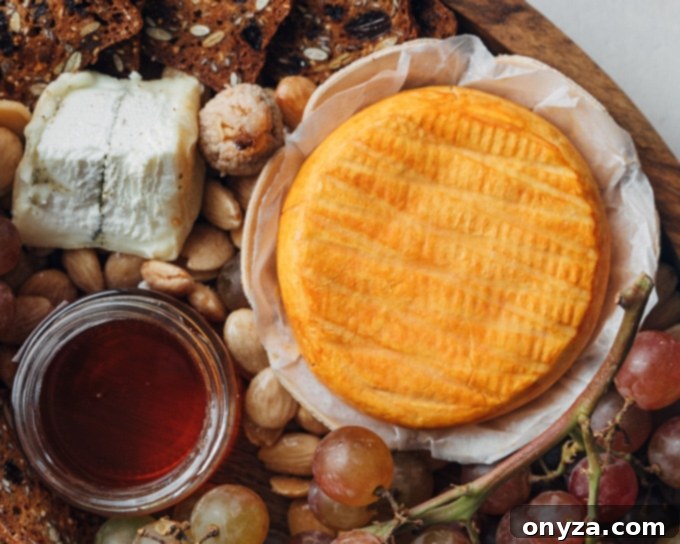Unleash the aroma! Explore the fascinating world of washed rind cheeses, uncovering the secrets behind their distinctive fragrance, diverse varieties, and optimal serving methods.

TABLE OF CONTENTS
(click headings to jump)
- What is Washed Rind Cheese? Unveiling the Mystery
- A Gallery of Washed Rind Cheese Varieties
- Mastering the Art of Serving Washed Rind Cheese
What is Washed Rind Cheese? Unveiling the Mystery
Washed rind cheeses are a unique and captivating category in the world of artisan dairy. Their distinctive character isn’t just a happy accident; it’s the result of a meticulously crafted aging process. During maturation, these cheeses are regularly “bathed” – either by dunking, brushing, or spraying – with a special solution. This washing liquid can be a simple saltwater brine, or it might be a more complex concoction of local spirits like brandy, wine, beer, or even cider. This intentional introduction of moisture during the aging period, which often spans from a swift 2-3 months to a lengthy 10-12 months, is the key to their legendary status.
The primary purpose of this washing ritual is to cultivate a specific ecosystem of edible bacteria on the cheese’s surface. The star player in this microbial drama is most frequently Brevibacterium linens, often simply referred to as B. linens. This fascinating bacteria thrives in the moist, controlled environment created by regular washing, establishing a vibrant, reddish-orange smear on the rind. Beyond encouraging B. linens, the washing solution also acts as a natural guardian, inhibiting the growth of less desirable molds and other bacterial strains that might otherwise dominate the rind. This precise control allows B. linens to flourish, guiding the cheese’s development both inside and out.
You might wonder how B. linens finds its way onto these cheeses. Sometimes, it’s a gift from the environment itself, naturally present in the caves or aging cellars where the cheese matures. In other cases, cheesemakers intentionally introduce it. This can happen by adding the culture directly to the milk at the initial stages of cheesemaking, or by inoculating the washing solution itself – a process often known as “smear-ripening.” Regardless of its origin, it is B. linens that is largely responsible for the famously “stinky” reputation of these cheeses, transforming them from humble curds into aromatic masterpieces.

Just How Pungent Are We Talking? The Aroma Spectrum
The intensity of a washed rind cheese’s aroma is as varied as the cheeses themselves. They can range from mildly earthy, offering just a hint of their unique character, to extraordinarily pungent, capable of making even seasoned cheese lovers take a step back. The scent profile often dances between a robust “farmy” note – evoking images of hay-filled barns and contented cows – and something surprisingly reminiscent of well-worn athletic footwear. Indeed, the olfactory experience can be so pronounced that Epoisses, a renowned French washed rind, was once famously banned from public transport in France due to its assertive aroma. Such anecdotes only add to the mystique and allure of these truly “funky” cheeses!
For those with a delicate disposition, this next detail might be best taken with a grain of salt. The scientific truth behind the “stink” is that B. linens isn’t exclusive to cheese. It’s a common inhabitant of human skin, thriving in warm, humid environments, such as those found between your toes or within a sweaty sock. This biological connection explains why the aroma of some powerful washed rind cheeses is often, and quite accurately, likened to a gym bag or, yes, even feet. While this fact might initially deter some, it’s a testament to the fascinating microbiology at play and should not overshadow the exceptional culinary experience that awaits.

Beyond the Aroma: Why Savor Stinky Cheese?
Despite their sometimes-intimidating aroma, washed rind cheeses are truly a delicacy worth exploring. It’s crucial to remember a fundamental truth about these cheeses: they are utterly delicious and their flavor profile almost never mirrors their potent scent. Many newcomers are astonished by the often-mild and complex tastes hidden beneath the assertive rind.
The unique bacterial activity, primarily driven by B. linens (which, to reiterate, is completely harmless and intentionally cultivated), ripens the cheese from the outside in. This ripening process is what develops the incredibly rich, savory, and nuanced flavors. Depending on the variety, you might encounter subtle notes of sweetness, profound nuttiness, deep earthy undertones, or even meaty, umami-rich characteristics. For the more intensely aromatic varieties, it may take a few tries to acclimate your palate, but if you can brave the bold bouquet, the depth and complexity of flavors are an incredibly rewarding experience. These cheeses offer a journey for the taste buds, promising an unforgettable gastronomic adventure.
Can You Eat the Rinds? A Culinary Question
When it comes to washed rind cheeses, the question of rind edibility is a common one. Technically, most of these rinds are indeed edible. However, whether you’ll *enjoy* eating them is another matter entirely, and it truly depends on the specific cheese and your personal preference. As the cheese ages, some washed rinds develop a noticeably sandy or gritty texture, which can be off-putting for some. Furthermore, the flavor of the rind can vary dramatically: some possess a very sharp or distinctly bitter edge, while others offer more appealing earthy, mushroomy, or even slightly sweet notes, often providing a unique contrast to the interior paste.
While consuming the rind can sometimes enhance the overall cheese experience by adding an extra layer of complexity and texture, it’s certainly not mandatory. Your best approach is to start by trying a small piece with the rind and letting your tastebuds be the ultimate judge. Don’t hesitate to consult with an experienced cheesemonger; they can offer invaluable advice on specific varieties, even providing a sample before you commit to a purchase. This allows you to discover which rinds complement your palate and which you might prefer to leave behind.

A Gallery of Washed Rind Cheese Varieties
The family of washed rind cheeses is incredibly diverse, offering a spectrum of textures, flavors, and aromas that cater to every palate. Texturally, they can range from supremely soft, almost liquid cheeses that ooze luxuriantly at room temperature (like the exquisite Pont L’Eveque pictured above) to semi-soft and even semi-hard varieties that can be cleanly sliced. While cow’s milk is the most common foundation for these cheeses, you’ll also encounter delightful washed rinds crafted from goat’s milk and sheep’s milk, each offering its own distinctive character. Let’s explore some of the most celebrated varieties you’re likely to discover at your local cheese counter, categorized by their typical texture.
Soft Washed Rind Varieties
These cheeses are often characterized by their intensely creamy, sometimes runny interiors and their robust, aromatic rinds. They are typically best enjoyed spread on bread or simply savored with a spoon.
- Epoisses (ay-PWOS); France: Hailing from the Burgundy region, Epoisses is a legendary cow’s milk cheese renowned for its potent aroma and incredibly rich, meaty flavor profile. Its striking red-orange rind is traditionally washed with Marc de Bourgogne, a local brandy, which contributes significantly to its robust character. At room temperature, it becomes wonderfully oozy and runny, making it perfect for dipping crusty, rustic bread directly into its ripened wheel. Epoisses is a quintessential example of how a “stinky” aroma can mask an utterly exquisite interior.
- Livarot (LEEV-ah-roh); France: Another pride of Normandy, Livarot is a soft, creamy cow’s milk cheese with a firm, pungent rind. Like Epoisses, it achieves an irresistible oozy texture at room temperature. Its flavor is a complex blend of nutty, spicy notes with a surprising citrusy zest. Distinctively, Livarot is traditionally wrapped with five reed strips (now often paper), which originally helped maintain its shape during aging. This unique banding earned it the affectionate nickname “le Colonel” among the French, due to its resemblance to military insignia.
- Munster (Munster Géromé); France: Not to be confused with the mild, sliceable American “Muenster,” the true Munster Géromé is a powerful soft cow’s milk cheese from the Alsace and Lorraine regions, nestled around the Vosges mountains. With a history stretching back to medieval Benedictine monks, this cheese boasts a creamy texture and a bold, beefy, nutty flavor underscored by a quintessential barnyard aroma. Its distinctive orange rind is frequently washed with a local schnapps or kirsch, enhancing its assertive character and deeply satisfying taste.
- Stinking Bishop; United Kingdom: With a name that leaves little to the imagination, Stinking Bishop is a proudly pungent washed rind cheese from Gloucestershire, England. Made from cow’s milk, its orange rind is bathed in perry, an alcoholic beverage made from fermented pears, specifically the local Stinking Bishop pear variety – hence the name. At room temperature, it develops a delightfully runny texture, akin to Epoisses and Livarot, offering a surprisingly sweet and clean flavor beneath its formidable aroma. It’s a testament to the fact that appearance and smell can be wonderfully deceiving.
Semi-Soft Washed Rind Varieties
These cheeses strike a balance between creaminess and firmness, making them versatile for slicing, melting, and enjoying on their own.
- Limburger (lim-bur-ger); Belgium, Germany, Netherlands: Perhaps one of the most famously aromatic cheeses globally, Limburger is a smooth, pasteurized cow’s milk cheese with a distinctive mushroomy, earthy flavor. While its aroma is undeniably potent, the taste is often surprisingly mellow and savory. For a true classic experience, seek out a Limburger Sandwich on rye or pumpernickel bread, often buttered, and generously topped with mustard and thinly sliced onions. It pairs exceptionally well with a cold, crisp beer, which helps to cut through its richness.
- Morbier (more–bee–ay); France: Originating from the Comté region of France, Morbier is an easily recognizable cow’s milk cheese due to its striking horizontal layer of edible ash (typically vegetable ash or charcoal) in the center. Historically, Comté cheesemakers created Morbier from leftover curds, using ash to protect the morning’s curds until the evening’s production could be added. This unique feature gives it a visually appealing distinction. Morbier possesses a yeasty, subtly sweet flavor with a pleasing elasticity, making it excellent for both cheese boards and culinary applications. (Delve deeper into the fascinating use of ash in cheese here.)
- Taleggio (Tah-ledge-ee-oh); Italy: Hailing from the Lombardy region of Italy, Taleggio is a cow’s milk cheese with a thin, rosy, pungent rind and a wonderfully creamy, yielding interior. Its flavor profile is a delightful blend of lightly tangy, dough-like notes with a fruity undertone, often much milder than its pronounced “barnyard” aroma suggests. Taleggio is an exceptional melting cheese, making it a superb choice for elevating your favorite dishes. Consider using it to add a sophisticated twist to your fondue, or incorporating it into a luxurious macaroni and cheese recipe, perhaps with prosciutto for an added depth of flavor.
Semi-Hard Washed Rind Varieties
These cheeses are firmer and often aged for longer periods, developing deeper, more complex nutty and savory characteristics, and excellent melting capabilities.
- Gruyère (groo-YAIR); Switzerland: A quintessential Swiss cheese, Gruyère is a smear-ripened cow’s milk cheese aged for a significant period, typically from 5 months to over a year. This extended maturation contributes to its incredibly complex aromatic profile, featuring nutty, earthy, and distinctly salty flavors. Gruyère’s exceptional melting properties make it indispensable in classic French cuisine, from gratin dishes to the beloved French onion soup. It also shines in more modern applications, such as my Savory Palmiers, where its rich flavor beautifully complements flaky pastry.
- Raclette (rah-KLETTE); Switzerland: More than just a cheese, Raclette is an experience, taking its name from the French word “racler,” meaning “to scrape.” This semi-hard cow’s milk cheese is traditionally served melted. Historically, a halved wheel of Raclette would be heated by an open fire, and as the surface became bubbly and blistered, the molten cheese would be scraped directly onto plates. Today, specialized Raclette grills and broiler tools are commonly used. The cheese itself has a wonderfully nutty flavor, often accompanied by a pronounced “footy” aroma when heated, which intensifies its savory depth. It’s most commonly enjoyed draped over boiled potatoes, cornichons, pickled onions, and served alongside various charcuterie, creating a convivial and delicious meal.

Mastering the Art of Serving Washed Rind Cheese
Serving washed rind cheeses thoughtfully can significantly enhance the enjoyment for both you and your guests. Their unique characteristics require a bit of special consideration, especially when presented on a diverse cheese board.
Firstly, due to their often-potent aromas, it’s wise to keep washed rind cheeses off the main cheeseboard until just before serving. This prevents their robust scent from permeating and potentially overpowering more delicate cheese styles, such as fresh goat cheese or mild Brie. Similarly, when storing these aromatic beauties in the refrigerator, always ensure they are individually wrapped, ideally in cheese paper or parchment paper, to contain their aroma and maintain their freshness without affecting other foods. Plastic wrap can trap too much moisture, potentially accelerating spoilage, so it’s generally best avoided for long-term storage.
When serving a washed rind cheese that guests will be cutting themselves, providing a dedicated knife is crucial. Just as you wouldn’t use the same utensil for a sweet dessert and a savory dish, cross-contamination of flavors between an intensely aromatic Epoisses and a delicate, creamy Brie can diminish the experience of both. A separate knife ensures each cheese’s distinct profile is appreciated without interference.
Optimal enjoyment of washed rind cheeses, much like bloomy rind varieties, is achieved when they are allowed to come to room temperature. This process softens their texture, allowing them to become wonderfully creamy and oozy (especially the softer types), and truly unlocks their full spectrum of complex flavors and aromas. On a cheese board, their assertive profiles pair beautifully with robust accompaniments. Think dark, crusty breads like rye or pumpernickel, which can stand up to their intensity. Cured meats such as prosciutto, salami, or coppa provide a savory counterpoint. And a selection of fresh and dried fruits – apples, pears, figs, grapes, apricots – offers a balancing sweetness and textural contrast. Nuts like walnuts and almonds, along with a dollop of fruit preserve or honey, can also create delightful pairings. For beverages, washed rinds shine alongside full-bodied red wines, crisp ciders, or a variety of beers, particularly Belgian ales, stouts, or robust lagers, whose maltiness and effervescence beautifully complement the cheese’s richness.
Whether you’re a seasoned connoisseur or a curious beginner, understanding the nuances of washed rind cheeses will elevate your appreciation for these extraordinary creations. Embrace their bold personality, and you’ll discover a world of unforgettable flavors.
From Feta to Swiss to Brie and beyond – uncover a world of delicious insights in our extensive library of Cheese Guides.
